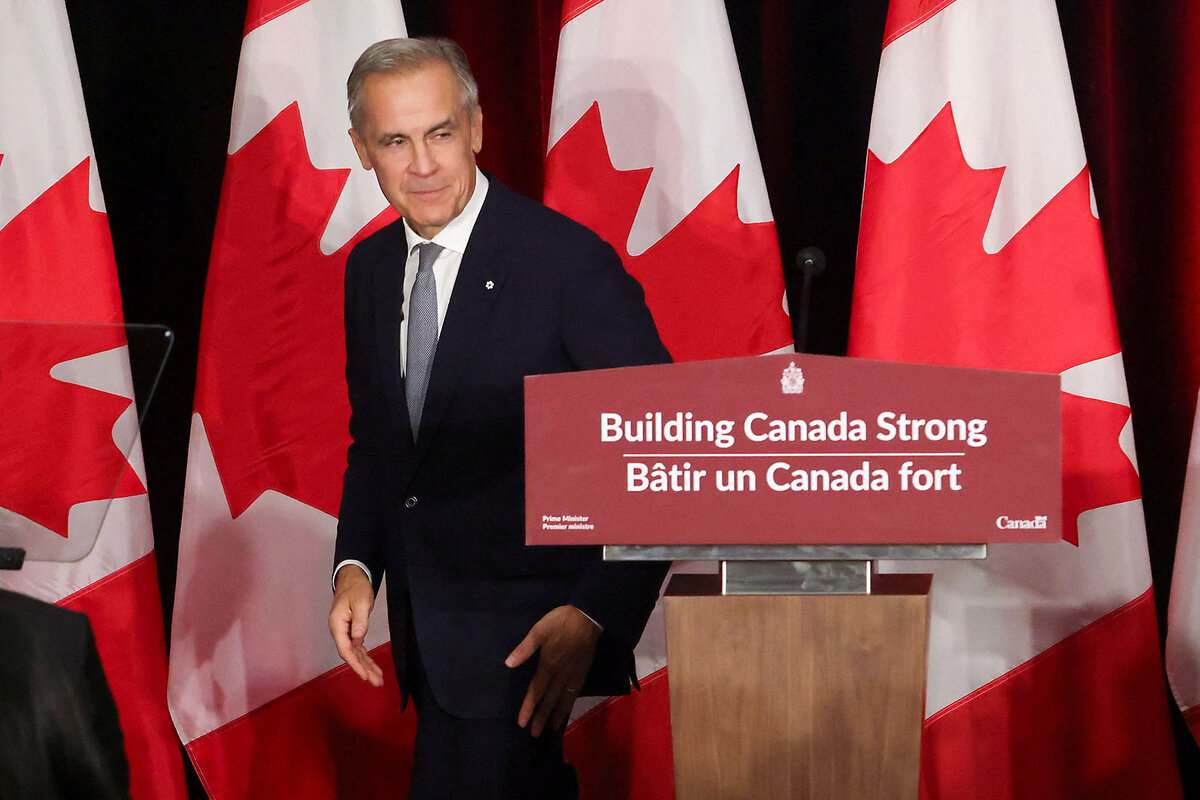Copyright csmonitor

It sounded almost like a wartime speech. Preparing the nation for an austere Nov. 4 budget, Prime Minister Mark Carney told Canadians that the four-decade era of ever-closer integration with the United States was over, and he called for patience and sacrifice as the nation moves to find other trading partners. It’s a message Americans will need to heed as well. Just as slower growth and job losses have hit the smaller Canadian economy, so they will hit the massive U.S. one. The difference: While the impact is evident in Canada, which is already seeing job losses and flirting with recession, in the U.S., the trade-war hit is still largely hidden. And the conflict might drag on for some time. Even as China and the U.S. have signaled a potential new framework for a trade deal, to be determined after a direct meeting Thursday between President Donald Trump and Chinese leader Xi Jinping, Mr. Trump threatened additional tariffs in response to a Canadian TV spot honoring President Ronald Reagan’s trade policies. America’s No. 2 and No. 3 trading partners, respectively, Canada and China, have the most to lose from a trade war. Both have retaliated when the U.S. has imposed new tariffs. But the differences are telling. Beijing has gone much more on the offensive, threatening curbs of its own – especially on rare earth metals – than Ottawa. China is a big geopolitical rival to the U.S., while Canada has been a staunch ally with a much smaller economic footprint. China also exports many finished goods – from TVs to smartphones – that compete directly with Western brands, while Canada’s exports are overwhelmingly goods such as steel parts and even energy that go into making those finished goods. That is why the costs of a trade war with Canada are far less visible to Americans than one with China, though equally compelling. Tariffs work like a hidden tax, which will cost American households an average of $1,300 this year and $2,000 next year, according to a Tax Foundation report issued on Monday. That’s the equivalent of the largest U.S. tax increase as a share of the economy since 1993, “surpassing the tax increases enacted under President Barack Obama and President George H.W. Bush,” the report found. Canada accounts for a chunk of those trade war costs, but in a very uneven way. The U.S.-Mexico-Canada trade deal, known as USMCA, protects the vast majority of Canada’s goods from U.S. tariffs, so that the average effective tariff is only about 3%, says Trevor Tombe, an economics professor at the University of Calgary. But high tariffs on non-USMCA goods, including steel and aluminum, mean that certain industries, concentrated in large industrial states bordering Canada, will likely be the hardest hit. Take Michigan, which last year sent more than one-third of its exports to Canada, its top foreign market. Tariffs will raise the price of Canadian car parts, making cars sold in the U.S. more expensive. Already, in August, the state’s labor force shrank for the fifth consecutive month, which has helped keep Michigan’s unemployment rate, the third-highest among the states, from worsening. An August report from Comerica Bank (now in the process of being acquired by Fifth Third Bancorp) forecasts that Michigan’s economy can keep pace with overall U.S. growth. But that might prove difficult over the long term. Between 2024 and 2028, tariffs will cut the average American’s inflation-adjusted income by 1%, according to a May study. For Michiganders, the income hit will be triple that level, in part because tariffs will raise the costs of Canadian (and Mexican) car parts, according to Andrés Rodríguez-Clare, an economist at the University of California, Berkeley, and the study’s lead author. Similarly, in Ohio, with an unemployment rate of 5%, among the highest in the country, business owners “are cautiously optimistic, but they’re still facing real uncertainty when it comes to trade, inflation, and workforce,” Steve Stivers, president of the Ohio Chamber of Commerce, said in a statement in August. The Buckeye State exports $19.9 billion of goods annually to Canada, including engines and turbines, plastics, and even candles. That’s more than the combined total sold to its next six top export destinations. Ohio’s top import, Canadian crude oil, gets refined in the U.S. Of course, things are worse on the other side of the border. Canadians have seen tariffs result in lost jobs and plant closures. The tariffs have hit industrial Ontario particularly hard, causing the province’s premier, Doug Ford, to become an outspoken critic of President Trump. On Friday and Saturday, during the first two games of the World Series that pits Ontario’s Toronto Blue Jays against the Los Angeles Dodgers, Mr. Ford ran a TV ad contrasting the hated tariffs with the free-trade policies of President Reagan. It drew instant backlash from President Trump. “Their Advertisement was to be taken down, IMMEDIATELY,’’ Mr. Trump posted on social media on Saturday. “But they let it run last night during the World Series, knowing that it was a FRAUD.” Mr. Trump then cut off trade talks with Ottawa and said he would increase tariffs on Canada by 10%. One irony of the current U.S.-Canada standoff is that, except for Canadian energy sales to the U.S., America actually has a trade surplus with Canada once services are added in. The USMCA free trade agreement, negotiated during Mr. Trump’s first term, is up for review next year. And Canadians worry that any new trade deal changes could weaken or eliminate that protection. “If that were to go away, that would be very, very, very impactful for Southwestern Ontario,” says Ryan Donally, head of the Windsor Essex Chamber of Commerce. Just across the border from Detroit, “Windsor would be in a very, very difficult spot because we do have upwards of 80 to 90% of our exports from Windsor-Essex that go to the U.S.,’’ he says. Despite these risks, Canada has not taken the tariffs lying down. In March, Ottawa responded in kind when the U.S. imposed 25% tariffs on steel, aluminum, and related products from Canada and most other trading partners. When carmaker Stellantis announced two weeks ago that it would move a major plant from Ontario to Illinois, costing the province some 3,000 jobs, the Canadian government responded by limiting how many cars Stellantis and General Motors can import into Canada tariff-free. More recently, Prime Minister Carney, who rode to office this year on a platform of navigating tariff turbulence with the U.S., rolled back some of these retaliatory measures to ease pressure on Canadian businesses. Ottawa, the Canadian capital whose name comes from the Algonquin word meaning “to trade,’’ has some leverage with Washington because of Canada’s natural resources and its geographical position as the United States’ northern neighbor. Canada has used Quebec hydropower to provide the U.S. with 60% of its aluminum, Mr. Carney said on Monday. The process to make it represents “the equivalent of the energy of 10 Hoover dams in the United States,” he said. Likewise, the U.S. lacks the domestic capacity to produce enough softwood lumber for its residential housing needs. “So a tariff on Canada is 100% a direct tax to U.S. consumers,” says Drew Dilkens, Windsor’s mayor. Even the tourism industry is feeling the pinch. Canadians make up the single biggest group of tourists to the U.S., spending $20.5 billion last year, according to the U.S. Travel Association. A 10% reduction in that flow would result in 14,000 American job losses. The number of Canadian residents returning from the U.S. by car in August dropped 34% compared with the same month last year, according to Statistics Canada. With North America’s only rare earth metals processing plant at commercial scale, Canada could also help ease the stranglehold that China has over rare earth metals critical to U.S. defense and commercial industries. Through binational organizations such as NORAD and other agreements, Canada’s armed forces help the U.S. patrol the skies, interdict illegal narcotics, and share information, among other cooperative activities. “The American economy can draw all the massive resources that Canada has, whether it’s oil ... other types of energy, whether it’s softwood lumber, whether it’s critical minerals,” says Asa McKercher, an expert on U.S.-Canada relations at the Brian Mulroney Institute of Government at St. Francis Xavier University in Nova Scotia. But as the Trump administration turns to “build an America for the future that will rival the Chinese,” he says, it has instead moved to “alienate friends and tank clients.” In the end, that hurts consumers in both countries. “All of this back and forth and unpredictability and internal inconsistency on the part of the U.S. is more damaging to Canada’s economy than the tariffs, by far,” says Professor Tombe at the University of Calgary. “I do hope that the two countries can converge on something that returns confidence to the business environment in both countries, so that we can get on with making sensible business decisions like we did before.”



